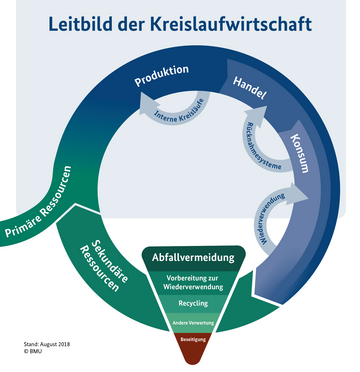Waste Policy
In the late 80s, it was feared that we were doomed to choke on our own waste due to a shortage of waste disposal sites and incineration plants. At first public and political interest was focused on making disposal sites safer and incineration plants cleaner. Municipalities and private disposal companies invested billions in environmentally sound waste disposal to meet the requirements.
At the same time, the threat of resource scarcity has made people aware of the need to close material cycles in order to recycle waste as secondary raw materials, but also to protect the environment from waste. The circular economy, a closed substance cycle, is the solution. A key objective is responsible resource management through waste recovery (primarily recycling, but also energy recovery). However, safe waste disposal by destroying pollutants and properly storing residues that can no longer be used remains vital to protect the environment.

The circular economy diagram shows the cycle of primary resources from production to trade and up to consumption. A waste recovery pyramid depicts how secondary resources are recycled.
Waste prevention is of highest priority. In accordance with the polluter-pays principle, both the waste producers and also the manufacturers of products have been held responsible. The best tool to achieve modern waste treatment besides bans and obligations is holding waste producers financially responsible. This can be done directly through fees or disposal charges and indirectly through producer responsibility.
Producer responsibility was introduced in the early 1990s. Through this responsibility, the conditions for effective and environmentally sound waste prevention and recovery are already created in the production stage. Producers and distributors must design their products in such a way as to reduce waste occurrence and allow environmentally sound recovery and disposal of by-products, both in the production of the goods and in their subsequent use. Producer responsibility was first laid down in 1991 in the Packaging Ordinance. The duty to exercise proper care was added in 2020.
The 1996 Closed Substance Cycle and Waste Management Act and the 2020 Circular Economy Act comprehensively extended these policies. According to the Act, producer responsibility can be implemented through legislation (laws, ordinances) as well as through voluntary commitments on the part of the producers and distributors. Little by little, regulations on producer responsibility were also established for vehicles, electrical and electronic devices, batteries and oil.
Phasing out the landfilling of biodegradable and other organic waste by June 2005 was another milestone in waste management. Through the provisions of the 2001 Waste Deposition Ordinance (later incorporated in the 2009 Landfill Ordinance), treatment has been required for waste such as domestic waste and commercial waste similar to domestic refuse in incineration or mechanical-biological treatment plants. This is a permanent step preventing the creation of climate-damaging landfill gas (methane) and polluted seepage in waste disposal sites.
With this triad of recycling, energetic recovery and safe deposition, combined with upstream waste prevention and the preparation for reuse, Germany has successfully developed a modern circular economy. This has a significant positive impact on the protection of soil, air, water and above all human health. At a time when resources are becoming scarcer and climate change is one of the great challenges of our age, the circular economy is making a significant contribution to climate action and resource conservation. Over the last years, climate-damaging greenhouse gas emissions from waste management, in particular methane, the main component of landfill gas, have decreased.
Currently over 280,000 people are employed in waste management, an economic sector with revenues of around 80 billion euros. There are around 15,000 waste treatment plants in Germany.
Germany's waste recovery rates are the highest in the world and show how the circular economy contributes to sustainable economic production in the country by saving raw materials and primary energy.
The German government's environmental target is to further enhance the circular economy and transform it into a comprehensive materials flow management over the coming years. Through a rigorous application of waste hierarchy, particularly by separating waste, pre-treatment, recycling and the recovery of energy, but also by an increase in resource productivity and more durable products, Germany aims to use substances and materials bound in waste as fully as possible.
